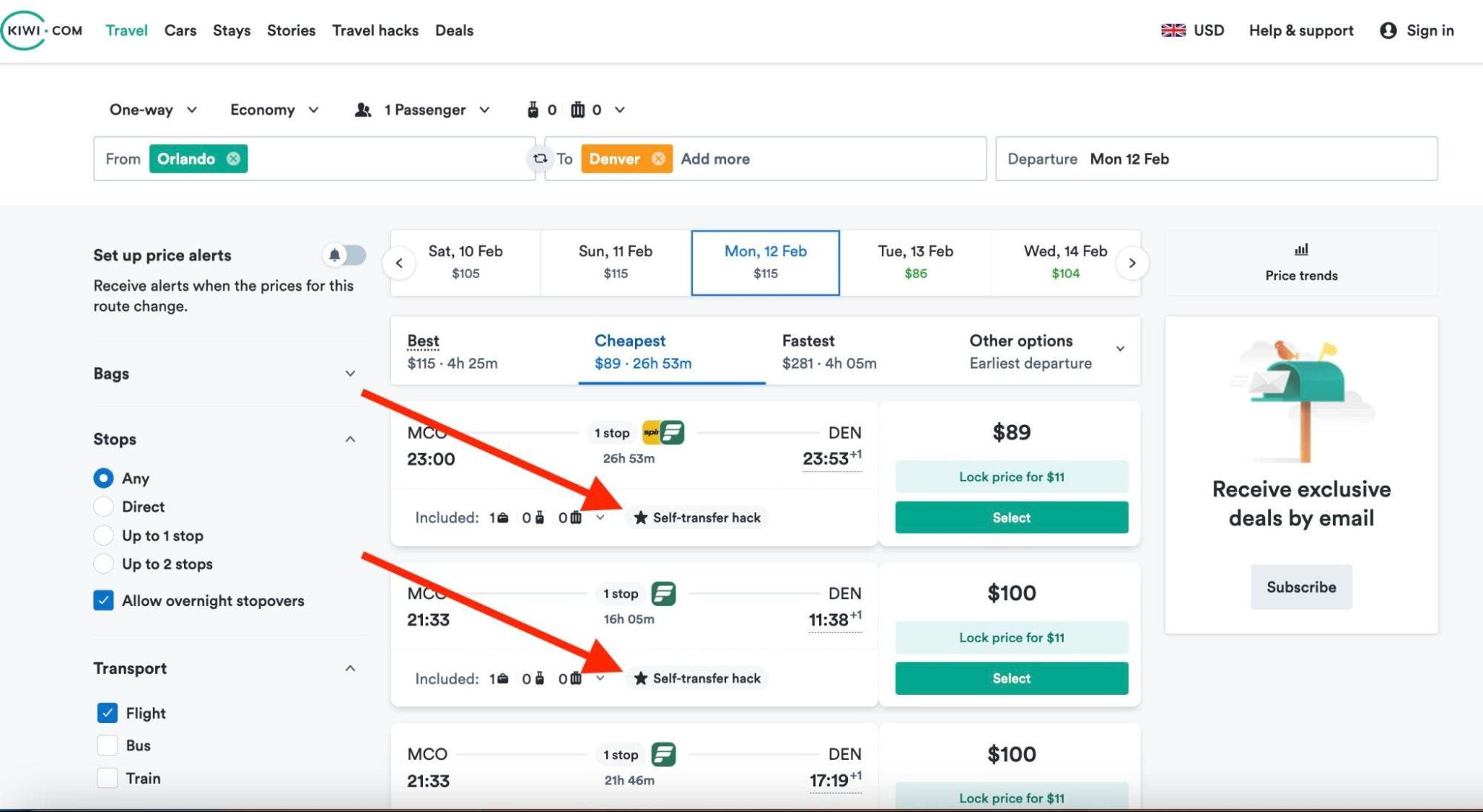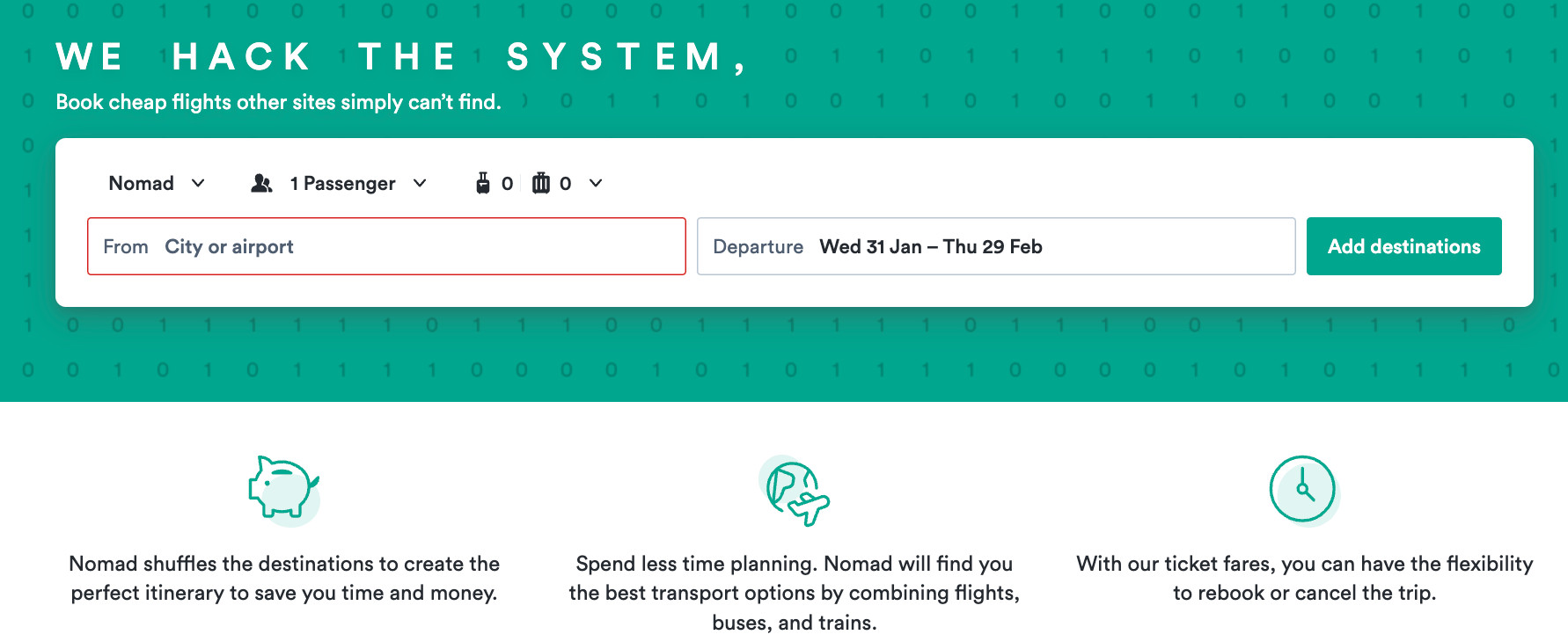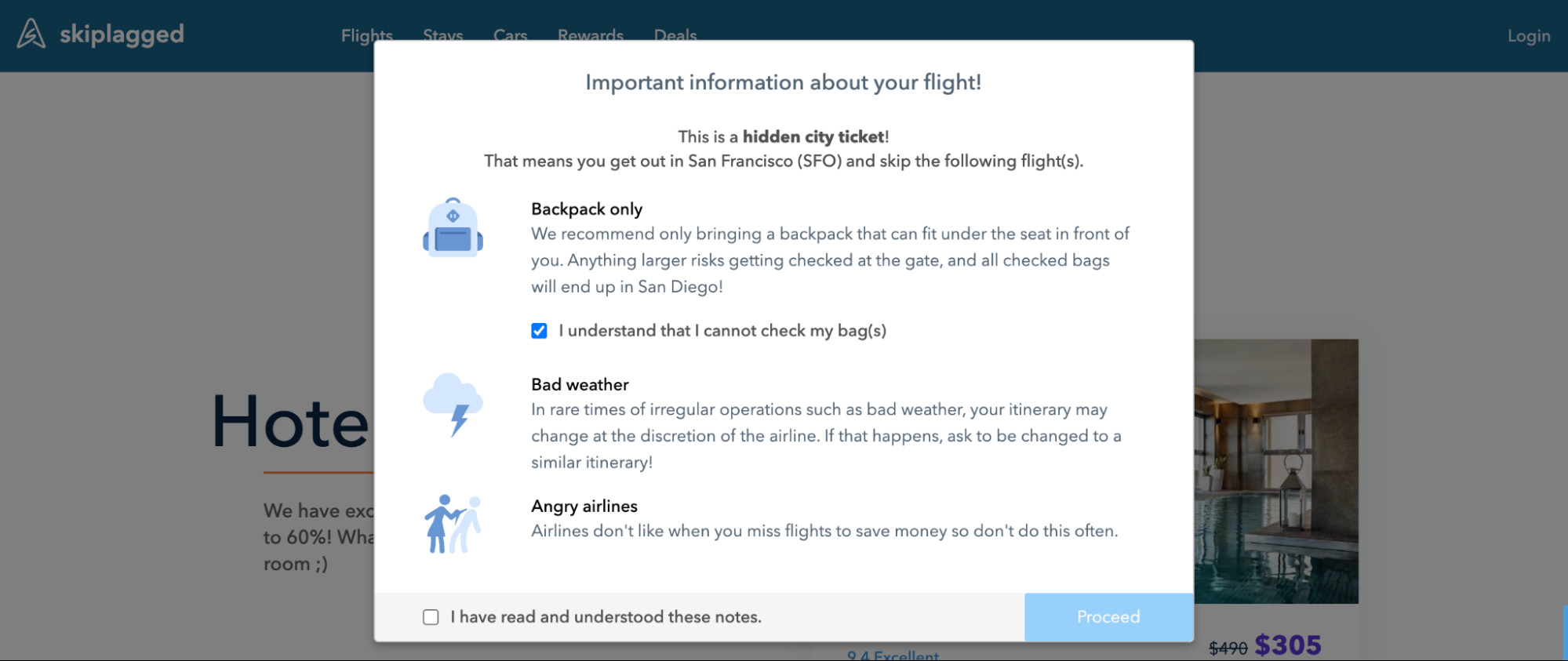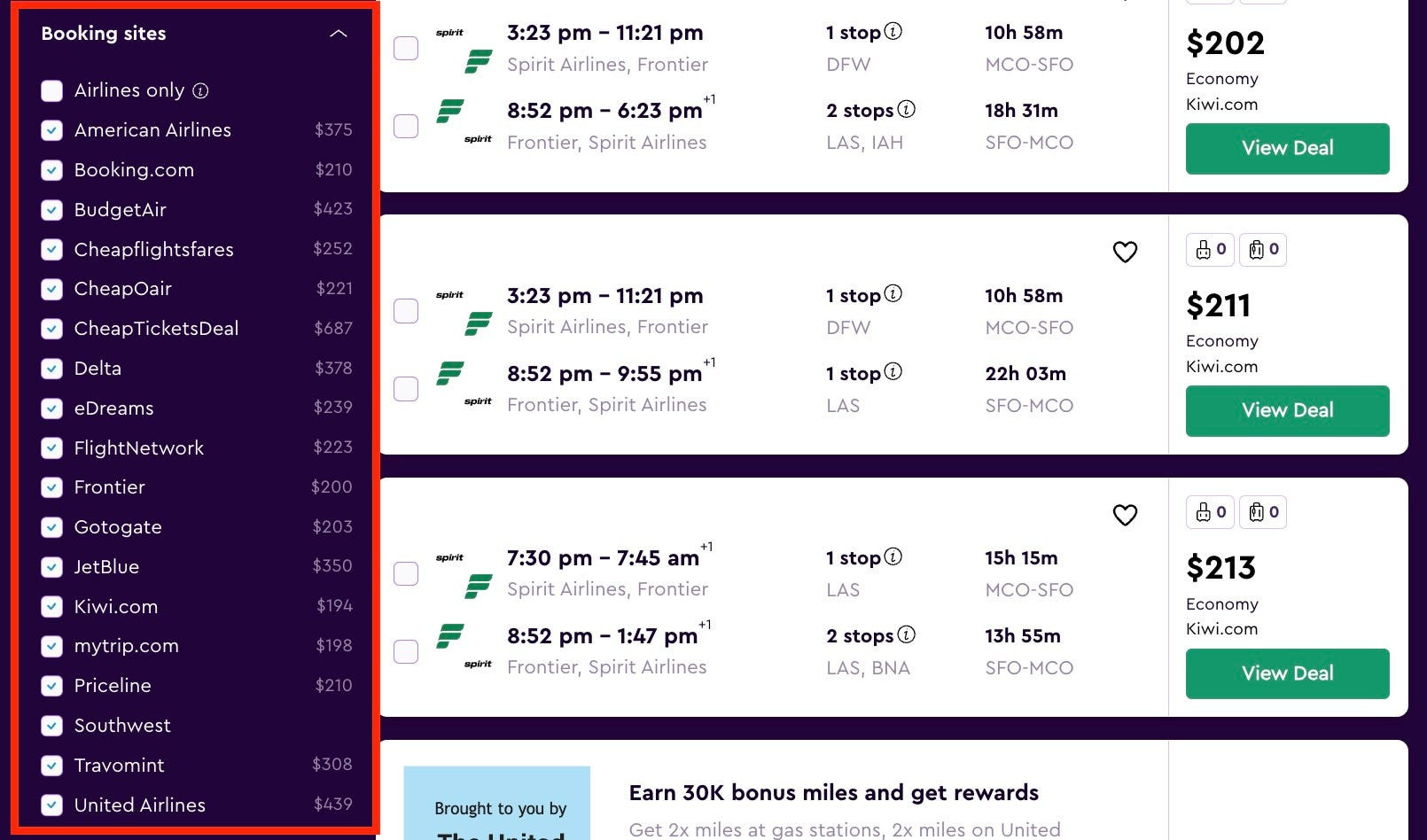Finding the best deals on air travel can be overwhelming with so many websites vying for your attention. For savvy travelers, knowing where to look is the first step to securing cheaper flights and a smoother booking experience. This guide dives into some of the top air travel sites, highlighting their strengths and weaknesses to help you choose the platform that best suits your travel needs. We’ll explore a range of options, from Online Travel Agencies (OTAs) to aggregators, each offering a unique approach to flight searching and booking.
Kiwi: Unlocking Unique Itineraries with Travel Hacks
Website type: OTA
Kiwi stands out for its ability to find remarkably low prices by employing unique itinerary combinations, often leveraging “travel hacks.” These hacks include self-transfer ticketing, hidden city ticketing, and throwaway ticketing. Kiwi particularly excels at self-transfer itineraries, which combine flights from different airlines to offer prices lower than booking with a single airline for the entire journey.
 Kiwi.com interface showing flight search results
Kiwi.com interface showing flight search results
While self-transfer tickets can lead to significant savings, it’s crucial to understand the potential downsides. Unlike flights booked through codeshare agreements, airlines in self-transfer itineraries operate independently. This means if you check baggage, you’ll likely need to retrieve it and re-check it with the connecting airline, often requiring you to exit and re-enter security. Furthermore, if a delay causes you to miss your connecting flight, you may not receive the same rebooking assistance you would with a single-airline booking.
If self-transfer itineraries seem too risky, Kiwi allows you to filter out these options using their “travel hacks” filters. Importantly, Kiwi also provides competitive fares on more conventional flight routes, making it a versatile option for various travel preferences.
Kiwi’s search capabilities extend beyond the standard one-way, round-trip, and multi-city options. Their unique “Nomad” feature is particularly useful for travelers with flexible destinations. Simply input your travel period and desired destinations, and Kiwi generates a cost-effective itinerary to visit them all. Additionally, Kiwi allows date flexibility, enabling searches up to five days before or after your intended travel date.
 Kiwi.com Nomad search feature for flexible multi-city trips
Kiwi.com Nomad search feature for flexible multi-city trips
As an OTA, Kiwi offers built-in protection options not typically available with aggregators. For an extra fee, you can lock in a quoted price for up to three days. The “Kiwi.com Guarantee” is another purchasable option that provides rebooking assistance or refunds in case of unexpected airline-initiated changes to your itinerary. This guarantee can offer valuable peace of mind, especially when booking unconventional itineraries.
While Kiwi provides a pricing trends table, it lacks price prediction features and a rewards program.
Pros:
- Displays unique itineraries utilizing “travel hacks” for potential savings.
- Offers various travel protection options.
- “Nomad” tool simplifies multi-city trip planning.
Cons:
- No rewards program.
- Lacks layover city filtering.
- “Travel hack” itineraries can be less convenient and carry risks.
Expedia: Ideal for One Key Rewards Program Members
Website type: OTA
Expedia is a strong choice for travelers invested in the One Key Rewards program. OneKeyCash earned through Expedia, Hotels.com, or Vrbo can be redeemed for flight bookings. However, flight bookings earn a modest 0.2% back in OneKeyCash, significantly less than the 2% earned on other eligible bookings.
Despite the low OneKeyCash earning rate, each flight booking contributes one “trip element” towards achieving higher One Key status tiers. Gold and Platinum One Key members enjoy complimentary price drop protection on flights booked through the Expedia app.
 Expedia website interface for flight booking
Expedia website interface for flight booking
Similar to other OTAs, Expedia offers optional flight protection add-ons. It’s worth noting that many travel credit cards include travel insurance benefits, so reviewing your credit card coverage before purchasing additional protection is advisable. Expedia provides a good range of sorting options, including less common filters like earliest or latest departure and return times. However, it notably lacks a “best” or “value” sorting option.
 Expedia flight search results page with sorting options
Expedia flight search results page with sorting options
Another peculiarity with Expedia’s sorting is relevant for round-trip flights. Sorting by criteria other than “lowest price” requires applying the desired sort to both departing and return flights separately. Even after sorting departing flights by, for example, “Duration (Shortest),” the return flights will default to sorting by “Price (Lowest).”
Expedia tends to focus on standard flight itineraries, generally avoiding “hidden city” ticketing strategies like those sometimes found on Skiplagged. Expedia primarily shows multi-airline itineraries involving codeshare partners, typically excluding self-transfer flights. This approach may be seen as a benefit for those prioritizing convenience and straightforward bookings, or a limitation for travelers solely seeking the lowest possible fare.
Pros:
- Each flight booking earns 1 One Key trip element.
- Free price drop protection for One Key Gold and Platinum members.
- Offers competitive pricing on conventional itineraries.
Cons:
- Round-trip flight sorting is less streamlined than some competitors.
- Low OneKeyCash earning rate on flights (0.2%).
- No option to sort by best value fares.
Skiplagged: The Go-To for Hidden City Ticketing (Use with Caution)
Website type: OTA
Skiplagged openly promotes “skiplagging,” or hidden city ticketing, a controversial tactic to potentially save money on flights.
Hidden city ticketing involves booking a flight with a layover at your desired destination, but instead of taking the connecting flight, you exit at the layover city. Counterintuitively, these flights with layovers can sometimes be cheaper than direct flights to the layover city.
Skiplagged’s focus on hidden city fares can unlock significantly lower prices compared to sites that don’t feature these itineraries. However, skiplagging comes with considerable risks. While self-transfer ticketing is generally tolerated by airlines, airlines actively discourage and penalize hidden city ticketing. Being caught could result in ticket cancellation, loss of frequent flyer miles, or even being banned from flying with the airline in the future.
Skiplagged acknowledges these risks and advises against frequent hidden city ticketing. They recommend traveling with only a backpack to minimize the risk of gate-checked carry-on baggage ending up at the intended final destination rather than your stopover city.
 Skiplagged website interface displaying flight deals
Skiplagged website interface displaying flight deals
Fortunately, Skiplagged allows users to easily disable the “Skiplagging” filter to exclude these itineraries from search results. Even without hidden city fares, Skiplagged often presents competitive prices. It also provides “Buy” or “Watch” recommendations based on historical pricing data, helping users decide when to book.
Skiplagged lags behind some competitors in pre- and post-search features. It does not support multi-city searches or flexible date searching. Additionally, the initial prices displayed on Skiplagged’s results page do not include service fees, which ranged from $10 to $35 in our evaluations. Skiplagged does offer a rewards program where users can earn up to $25 per flight or hotel booking made directly or through a shared referral link.
Pros:
- Displays hidden city flights for potentially substantial savings.
- Offers “Buy” or “Watch” recommendations based on price trends.
- Features a rewards and referral program.
Cons:
- Displayed prices exclude service fees.
- No multi-city search functionality.
- Fewer filter options compared to other sites.
Momondo: Superior Search Filters and Price Insights
Website type: Aggregator
Momondo operates as an aggregator, meaning you typically won’t book flights directly through their site. Instead, Momondo directs you to the airline or OTA’s website to complete the booking. Momondo conveniently displays fares from both airlines and OTAs side-by-side, allowing you to compare prices and choose your preferred booking source. You can also filter out specific sites or choose to view “Airlines only.”
 Momondo flight search interface
Momondo flight search interface
Momondo shares its robust filtering system with its sister site, Kayak, earning top marks for filter options. You can refine your search by airline, alliance, cabin class, seat selection, baggage allowance, trip duration, number of layovers, and many other criteria.
While Momondo and Kayak offer similar functionalities, Momondo distinguishes itself with its exceptional price charts and insights. Above the search results, a chart displays daily price fluctuations for several days before and after your selected dates.
 Momondo price trend chart for flight search results
Momondo price trend chart for flight search results
The expandable “insights” menu at the top of the page provides valuable information, including the cheapest month, day of the week, time of day, and airline for your route. It also advises on the optimal booking window to secure the lowest fares for your destination.
As an aggregator, Momondo doesn’t offer a rewards program or travel protections. However, the airline or OTA you are redirected to may offer these options. Momondo may display self-transfer tickets from Kiwi or other OTAs. To exclude these, you can deselect “show flights with self-transfers” within the “Flight quality” filters. Momondo does not promote skiplagging fares.
Pros:
- Best-in-class price history charts and graphs for informed booking decisions.
- Extensive filter options to customize your flight search.
- Shows both airline-direct fares and third-party OTA prices.
Cons:
- No rewards program.
- No travel insurance or price protection offered directly.
- Ads at the top of search results can sometimes be misleading.
Google Flights: Top-Tier Price Prediction and Tracking
Like Momondo, Google Flights is a powerful travel aggregator. For flights within the U.S., you may have the option to “Book on Google,” but this typically redirects you to the airline or OTA to finalize the purchase. Google acts as an intermediary, without providing its own travel protections or rewards programs. While you cannot filter out OTAs on Google Flights, you can filter by specific airlines.
Google Flights leverages Google’s data expertise to offer superior price prediction features. Based on historical data, it indicates whether current prices for your trip are low, typical, or high. If prices are predicted to be at their lowest, Google may even suggest a specific date to book before prices are likely to increase.
For price tracking, Google Flights excels. You can track prices for specific dates and receive email alerts when prices change. Going beyond basic price alerts, Google Flights offers “Any dates” tracking for your route. This feature is invaluable for travelers with flexible dates, helping them identify the cheapest time to fly to their desired destination.
 Google Flights interface showing price tracking and prediction
Google Flights interface showing price tracking and prediction
Google’s “Explore” tool is exceptional for travelers with destination flexibility. By entering your departure city and “Anywhere” as the destination, Google Flights displays a map with fares to various cities. You can pan and zoom the map to explore different regions or continents. Leveraging Google Maps data, the “Explore” tool also showcases popular attractions, photos, and traveler reviews for each destination, providing travel inspiration.
Google Flights is one of the few platforms that includes Southwest Airlines in its search results. While it cannot display Southwest prices directly, it provides a link to the Southwest website for direct price checking. Self-transfer tickets are shown by default but can be hidden using the “Separate tickets” filter.
Pros:
- Excellent price prediction and tracking capabilities.
- “Explore” tool is ideal for flexible destination searches.
- Includes Southwest Airlines in search results (with link to their site).
Cons:
- No travel protections offered through Google Flights.
- No rewards program.
- Cannot filter out specific third-party booking sites.
Choosing the Right Air Travel Site for You
Selecting the “best” air travel site depends on your individual priorities and travel style.
- For budget-conscious travelers willing to consider unconventional itineraries and potential risks, Kiwi and Skiplagged offer unique options. However, exercise caution with Skiplagged’s hidden city ticketing due to airline restrictions.
- Expedia is well-suited for loyal members of the One Key Rewards program.
- Momondo and Google Flights are excellent aggregators for comprehensive searches, price comparison, and leveraging price insights and tracking tools to make informed booking decisions. Momondo excels in filtering and price charts, while Google Flights shines with price prediction and its “Explore” tool.
By understanding the strengths and weaknesses of each platform, you can confidently choose the air travel site that best empowers you to find affordable flights and plan your next journey.

